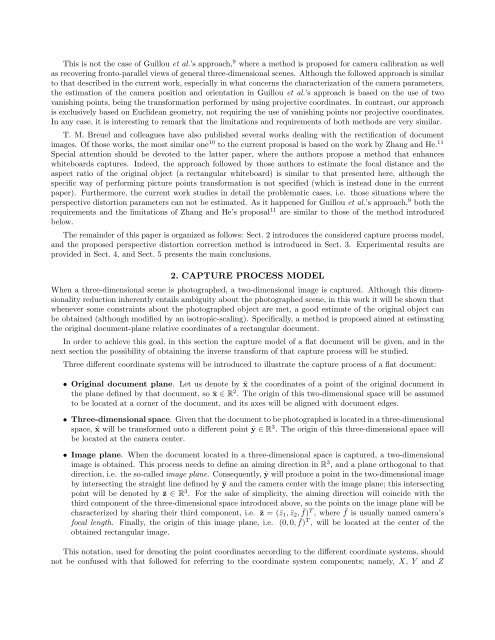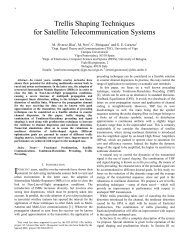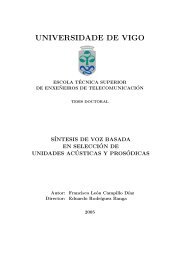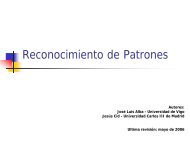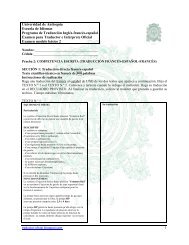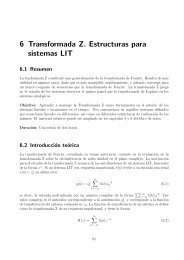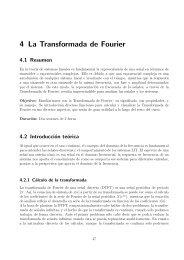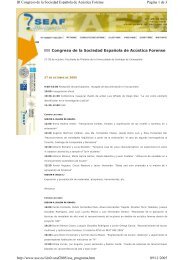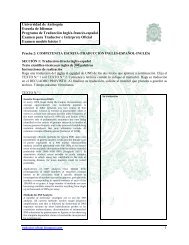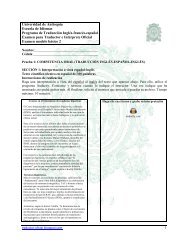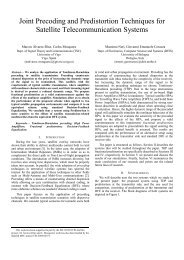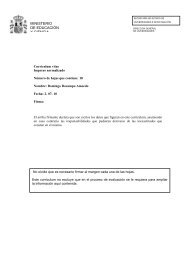in the <strong>document</strong> image, and some parameters that are not automatically tuned, like some parameters used todiscard false detections <strong>of</strong> top and bottom lines <strong>of</strong> the text; thus, small changes on the value <strong>of</strong> those parameterscan make the <strong>method</strong> fail. More recently, Lu and Tan have presented an extended version <strong>of</strong> the mentionedwork, 3 although it inherits the discussed drawbacks.Morphological operations are also used in the <strong>method</strong> proposed by Miao and Peng, 4 although a smallerknowledge about the contents <strong>of</strong> the <strong>document</strong> is required in comparison with Lu et al.’s aproaches. Additionally,an adaptive thresholding technique is adopted to binarize the capture, which makes the <strong>method</strong> capable <strong>of</strong> dealingwith lighting variations. Nevertheless, no clue is provided on how to obtain the value <strong>of</strong> some parameters —likethe size <strong>of</strong> structure elements used to cluster the detected connected components into text lines—. Furthermore,the image <strong>correction</strong> process requires the use <strong>of</strong> three trans<strong>for</strong>mations, which are computationally expensive.Methods that do not depend so much on the contents <strong>of</strong> the <strong>document</strong>, as they are not exclusively aimed attext-based <strong>document</strong>s, are due to Yun. 5,6 The first <strong>of</strong> them is centered on the <strong>perspective</strong> estimation problem,while the second one is focused on the rectification system design. Indeed, Yin et al. 5 describe a <strong>method</strong> thatuses textual in<strong>for</strong>mation —if it is available— and also other sources <strong>of</strong> in<strong>for</strong>mation, such as <strong>document</strong> boundaries.Nevertheless, most <strong>of</strong> the <strong>method</strong> is based on the clues provided by textual in<strong>for</strong>mation. In this case there arealso some parameters that are not automatically tuned —like the thresholds used to classify a detected line ashorizontal—. On the other hand, both <strong>method</strong>s are carefully designed to minimize the computational cost. Infact, a multi-stage approach to <strong>perspective</strong> <strong>correction</strong> is proposed 6 which is able to avoid some unnecesary stages.Nevertheless, the most important drawback <strong>of</strong> these <strong>method</strong>s is the fact that they are not able to recover theoriginal aspect ratio <strong>of</strong> the <strong>document</strong>.Iwamura et al. 7 proposed a <strong>method</strong> that estimates the depth <strong>of</strong> each area <strong>of</strong> the <strong>document</strong> by using measurements<strong>of</strong> its textual contents, like the variation <strong>of</strong> the area <strong>of</strong> characters with respect to their position.Nevertheless, the proposed aproach does not obtain the focal length, being only able to recover an affine distortedversion <strong>of</strong> the original <strong>document</strong>.Finally, there exist some considerations that can make the <strong>method</strong>s based on text <strong>document</strong>s undesirable<strong>for</strong> general applications. First <strong>of</strong> all, it is obvious that the requirement <strong>of</strong> dealing with text <strong>document</strong>s reducesthe generality <strong>of</strong> the designed <strong>method</strong>s, and hence, the potential number <strong>of</strong> applications. In addition, most <strong>of</strong>the described <strong>method</strong>s constrain features like the size <strong>of</strong> the text, as well as its variation over the <strong>document</strong>, orparameters about the paragraphs <strong>for</strong>matting. Furthermore, according to the described algorithms, most <strong>of</strong> themcould fail when restoring handwritten <strong>document</strong>s, or those written with some particular typographies, such asitalics, where the tips <strong>of</strong> the characters are not vertical. Also, the presence <strong>of</strong> several columns <strong>of</strong> text can makesome <strong>method</strong>s fail, as well as the consideration <strong>of</strong> different alphabets —like some kinds <strong>of</strong> writing that are notordered from left to right and from top to bottom—. According to these facts, it is reasonable to pay attentionto those <strong>method</strong>s that do not require the presence <strong>of</strong> text in the <strong>document</strong>.1.2 Methods not requiring text in the <strong>document</strong>A more theoretic approach than those followed in the <strong>method</strong>s presented in the previous section is introducedby Liebowitz and Zisserman. 8 This approach is not only suitable <strong>for</strong> recovering the fronto-parallel view <strong>of</strong> text<strong>document</strong>s, but also <strong>for</strong> describing the geometry, constraints and algorithmic implementations that allow metricproperties <strong>of</strong> figures on a plane, like angles and length ratios, to be measured from a captured image <strong>of</strong> that plane.Perhaps the most novel contribution <strong>of</strong> this work is the presentation <strong>of</strong> different ways <strong>of</strong> providing geometricalconstraints, including the availability <strong>of</strong> a known angle in the original scene, two equal but unknown angles, or aknown length ratio. Un<strong>for</strong>tunately, <strong>for</strong>mal pro<strong>of</strong>s supporting those procedures are not provided. It must be alsonoted that, depending on the level <strong>of</strong> knowdelegde about the contents <strong>of</strong> the <strong>document</strong> —measured by means <strong>of</strong>the number <strong>of</strong> known pairs <strong>of</strong> orthogonal lines in the original scene—, more than a single image trans<strong>for</strong>mationmay be required.On the other hand, there also exist a great number <strong>of</strong> publications that deal with camera calibration. Althoughthey are not designed <strong>for</strong> per<strong>for</strong>ming <strong>perspective</strong> distortion <strong>correction</strong> <strong>of</strong> captures, they can be used to estimatethe camera position and its orientation in relation to the imaged <strong>document</strong>. Un<strong>for</strong>tunately, since those <strong>method</strong>shave been designed <strong>for</strong> other purposes, most <strong>of</strong> them cannot be applied to the <strong>perspective</strong> distortion <strong>correction</strong>problem.
This is not the case <strong>of</strong> Guillou et al.’s approach, 9 where a <strong>method</strong> is proposed <strong>for</strong> camera calibration as wellas recovering fronto-parallel views <strong>of</strong> general three-dimensional scenes. Although the followed approach is similarto that described in the current work, especially in what concerns the characterization <strong>of</strong> the camera parameters,the estimation <strong>of</strong> the camera position and orientation in Guillou et al.’s approach is based on the use <strong>of</strong> twovanishing points, being the trans<strong>for</strong>mation per<strong>for</strong>med by using projective coordinates. In contrast, our approachis exclusively based on Euclidean geometry, not requiring the use <strong>of</strong> vanishing points nor projective coordinates.In any case, it is interesting to remark that the limitations and requirements <strong>of</strong> both <strong>method</strong>s are very similar.T. M. Breuel and colleagues have also published several works dealing with the rectification <strong>of</strong> <strong>document</strong><strong>images</strong>. Of those works, the most similar one 10 to the current proposal is based on the work by Zhang and He. 11Special attention should be devoted to the latter paper, where the authors propose a <strong>method</strong> that enhanceswhiteboards captures. Indeed, the approach followed by those authors to estimate the focal distance and theaspect ratio <strong>of</strong> the original object (a rectangular whiteboard) is similar to that presented here, although thespecific way <strong>of</strong> per<strong>for</strong>ming picture points trans<strong>for</strong>mation is not specified (which is instead done in the currentpaper). Furthermore, the current work studies in detail the problematic cases, i.e. those situations where the<strong>perspective</strong> distortion parameters can not be estimated. As it happened <strong>for</strong> Guillou et al.’s approach, 9 both therequirements and the limitations <strong>of</strong> Zhang and He’s proposal 11 are similar to those <strong>of</strong> the <strong>method</strong> introducedbelow.The remainder <strong>of</strong> this paper is organized as follows: Sect. 2 introduces the considered capture process model,and the proposed <strong>perspective</strong> distortion <strong>correction</strong> <strong>method</strong> is introduced in Sect. 3. Experimental results areprovided in Sect. 4, and Sect. 5 presents the main conclusions.2. CAPTURE PROCESS MODELWhen a three-dimensional scene is photographed, a two-dimensional image is captured. Although this dimensionalityreduction inherently entails ambiguity about the photographed scene, in this work it will be shown thatwhenever some constraints about the photographed object are met, a good estimate <strong>of</strong> the original object canbe obtained (although modified by an isotropic-scaling). Specifically, a <strong>method</strong> is proposed aimed at estimatingthe original <strong>document</strong>-plane relative coordinates <strong>of</strong> a rectangular <strong>document</strong>.In order to achieve this goal, in this section the capture model <strong>of</strong> a flat <strong>document</strong> will be given, and in thenext section the possibility <strong>of</strong> obtaining the inverse trans<strong>for</strong>m <strong>of</strong> that capture process will be studied.Three different coordinate systems will be introduced to illustrate the capture process <strong>of</strong> a flat <strong>document</strong>:• Original <strong>document</strong> plane. Let us denote by ¯x the coordinates <strong>of</strong> a point <strong>of</strong> the original <strong>document</strong> inthe plane defined by that <strong>document</strong>, so ¯x ∈ R 2 . The origin <strong>of</strong> this two-dimensional space will be assumedto be located at a corner <strong>of</strong> the <strong>document</strong>, and its axes will be aligned with <strong>document</strong> edges.• Three-dimensional space. Given that the <strong>document</strong> to be photographed is located in a three-dimensionalspace, ¯x will be trans<strong>for</strong>med onto a different point ȳ ∈ R 3 . The origin <strong>of</strong> this three-dimensional space willbe located at the camera center.• Image plane. When the <strong>document</strong> located in a three-dimensional space is captured, a two-dimensionalimage is obtained. This process needs to define an aiming direction in R 3 , and a plane orthogonal to thatdirection, i.e. the so-called image plane. Consequently, ȳ will produce a point in the two-dimensional imageby intersecting the straight line defined by ȳ and the camera center with the image plane; this intersectingpoint will be denoted by ¯z ∈ R 3 . For the sake <strong>of</strong> simplicity, the aiming direction will coincide with thethird component <strong>of</strong> the three-dimensional space introduced above, so the points on the image plane will becharacterized by sharing their third component, i.e. ¯z = (¯z 1 , ¯z 2 , ¯f) T , where ¯f is usually named camera’sfocal length. Finally, the origin <strong>of</strong> this image plane, i.e. (0,0, ¯f) T , will be located at the center <strong>of</strong> theobtained rectangular image.This notation, used <strong>for</strong> denoting the point coordinates according to the different coordinate systems, shouldnot be confused with that followed <strong>for</strong> referring to the coordinate system components; namely, X, Y and Z


